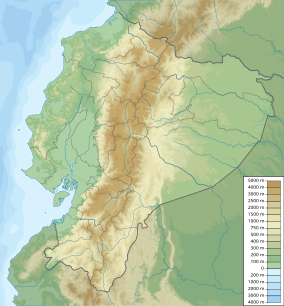Cuyabeno Wildlife Reserve
| Cuyabeno Wildlife Reserve | |
|---|---|
|
IUCN category VI (protected area with sustainable use of natural resources)
|
|
 |
|
| Location |
Ecuador Sucumbíos Province, Putumayo Canton; Orellana Province, Aguarico Canton |
| Coordinates | 0°07′00″S 75°50′00″W / 0.1167°S 75.8333°WCoordinates: 0°07′00″S 75°50′00″W / 0.1167°S 75.8333°W |
| Area | 6033.8 km² |
| Established | 1979 |
The Cuyabeno Wildlife Reserve (Spanish: Reserva de Producción Faunística Cuyabeno) is the second largest reserve of the 45 national parks and protected areas in Ecuador. It is located in the Putumayo Canton in the Sucumbíos Province and in the Aguarico Canton in the Orellana Province. It was decreed on 26 July 1979 as part of the creation of the national protected areas system based on the recommendations of the FAO report on the "National Strategy on the Conservation of Outstanding Wild Areas of Ecuador".
From east to west, the elevation gently slopes from about 300 meters to slightly under 200 m above sea level and has an area of 603,380 ha (1,490,000 acres). The upper watershed being still close to the Andes, the weather seems slightly milder than more eastern parts of the Amazon, with temperatures a bit lower during the day and at night usually cooling to the low twenties (°C) or seventies (°F).
The Cuyabeno Wildlife Reserve is an important nature reserve in Amazonia with rather unusual ecological characteristics. Located at the foothills of the Andes, it is different from any other Amazon protected area in the world. The area encompasses a poorly drained plain with a network of periodically inundated forests, lakes and creeks. Such conditions are rare so close to the Andes, where the drainage in the foothills prevents the development of swamps and lakes. Given its proximity to the mountains, combined with a slightly cooler and wetter climate it may be expected to have a partly different species composition than other areas in the upper Amazon watershed. As all protected areas in the Amazon region, the area has a high biodiversity, but possibly a bit lower than better drained protected areas like the neighbouring Yasuni National Park, which is considered the most diverse park in the world. However, such claims must be met with caution, as insufficient data of other areas exist to scientifically compare the diversity of areas. Moreover, to the incidental visiting tourist or even professional biologist such differences are irrelevant because all areas close to the Andes are incredibly rich in species.
There are eight major ecosystems in Cuyabeno:
...
Wikipedia

